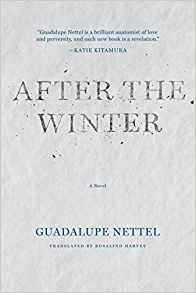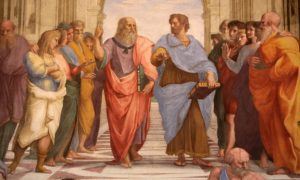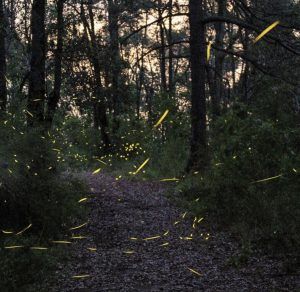Walter Biggins at The Quarterly Conversation:
 In capturing the voices, travails, and eventual connection of two lonelyhearts, Guadalupe Nettel’s After the Winter captures the spirit of urban loneliness so vividly that it’s often painful to read. But, as with her story collection Natural Histories (2013) and novel The Body Where I Was Born (2011), Nettel casts a sardonic, cocked eye at all the sadness. She’s funny, wickedly so, just as much as she shows us these lonely souls from the perspectives of others.
In capturing the voices, travails, and eventual connection of two lonelyhearts, Guadalupe Nettel’s After the Winter captures the spirit of urban loneliness so vividly that it’s often painful to read. But, as with her story collection Natural Histories (2013) and novel The Body Where I Was Born (2011), Nettel casts a sardonic, cocked eye at all the sadness. She’s funny, wickedly so, just as much as she shows us these lonely souls from the perspectives of others.
Nettel’s alternate points-of-view are initially hard to see, as After the Winter is resolutely told from the first-person. The chapters alternate between Claudio, a Cuban expat in New York, and Cecilia, a Mexican expat in Paris. The narratives build separately as they evoke their funny, sad lives, until the moment that these lives—and their love and loin—converge. Until that union, these two are trapped in their own heads and cluttered apartments.
more here.

 If it sounds as if the movie’s depiction of authenticity, especially in the case of Gaga, is somehow blinkered, this isn’t the case. “Gaga: Five Foot Two,” in its focus on its subject’s usually concealed struggles, willfully disregarded the showiness inherent even in her most private actions. “A Star Is Born,” however, is able to accommodate exactly this doubleness. Cooper’s movie presents itself as the greatest love story ever told. It’s an emotional blockbuster, visually grand, and, within the logic of its world, meaningful gestures undertaken by larger-than-life characters—a single tear trailing down Ally’s face, Maines’s finger tracing the outline of her strong nose, Ally cupping Maines’s cheek—take on a duality that Gaga’s skills are exactly made for. She is both the dressed-down girl next door and the mythical superstar, and her ability to nimbly straddle these two poles is what makes her performance great. What came across in the documentary as an uncomfortable mix produces a satisfying combination in an outsized epos like this one, the two impulses tempering and complementing each other.
If it sounds as if the movie’s depiction of authenticity, especially in the case of Gaga, is somehow blinkered, this isn’t the case. “Gaga: Five Foot Two,” in its focus on its subject’s usually concealed struggles, willfully disregarded the showiness inherent even in her most private actions. “A Star Is Born,” however, is able to accommodate exactly this doubleness. Cooper’s movie presents itself as the greatest love story ever told. It’s an emotional blockbuster, visually grand, and, within the logic of its world, meaningful gestures undertaken by larger-than-life characters—a single tear trailing down Ally’s face, Maines’s finger tracing the outline of her strong nose, Ally cupping Maines’s cheek—take on a duality that Gaga’s skills are exactly made for. She is both the dressed-down girl next door and the mythical superstar, and her ability to nimbly straddle these two poles is what makes her performance great. What came across in the documentary as an uncomfortable mix produces a satisfying combination in an outsized epos like this one, the two impulses tempering and complementing each other. Sam Moyn in The Boston Review:
Sam Moyn in The Boston Review: Ancient Greeks often wondered whether non-Greeks could do philosophy. Some thought the discipline had its origins in the wisdom of Egypt and Mesopotamia. Some counted itinerant Scythian sages or Jewish preachers as philosophers. Others said no: whatever the intellectual merits of neighbouring peoples, it is a distinctively Greek practice. A new, angrier version of that ancient debate has arisen amid the culture wars of the last 50 years. Is philosophy an exclusively western phenomenon? Or is denying it to non-western peoples a form of neocolonialism? Or does the imperialism lie, rather, in folding non-western thought into a western category? Difficult questions, and the answers are not always obvious.
Ancient Greeks often wondered whether non-Greeks could do philosophy. Some thought the discipline had its origins in the wisdom of Egypt and Mesopotamia. Some counted itinerant Scythian sages or Jewish preachers as philosophers. Others said no: whatever the intellectual merits of neighbouring peoples, it is a distinctively Greek practice. A new, angrier version of that ancient debate has arisen amid the culture wars of the last 50 years. Is philosophy an exclusively western phenomenon? Or is denying it to non-western peoples a form of neocolonialism? Or does the imperialism lie, rather, in folding non-western thought into a western category? Difficult questions, and the answers are not always obvious. Is it possible to transform politics around values such as empathy, solidarity and love? Many progressive commentators think so, and have
Is it possible to transform politics around values such as empathy, solidarity and love? Many progressive commentators think so, and have  A few hours after sunset one night in July of 2016, a Ph.D. student walked into a New Jersey hotel carrying a bouquet of butterfly nets. The travelers who usually occupy the place looked up from their lonely business trips, curious to hear what Tim Fallon had caught. Tangled up in the mesh, he said, were about 100 fireflies, freshly nabbed from a local meadow as they blinked their way toward reproductive fulfillment.
A few hours after sunset one night in July of 2016, a Ph.D. student walked into a New Jersey hotel carrying a bouquet of butterfly nets. The travelers who usually occupy the place looked up from their lonely business trips, curious to hear what Tim Fallon had caught. Tangled up in the mesh, he said, were about 100 fireflies, freshly nabbed from a local meadow as they blinked their way toward reproductive fulfillment. Some scholars applauded the hoax.
Some scholars applauded the hoax. By the end of the twentieth century, the landscape of social thought had changed radically. The pressures bearing down on individuals had not in the least diminished. But, to a great extent, earlier ways of imagining self and society had broken apart. Strong notions of society receded from the forefront of language and imagination. Structures and institutions became less visible. Talk of power grew more abstract. In their place,rights-bearing, choice-making, autonomously acting individuals took centre stage in social thought.
By the end of the twentieth century, the landscape of social thought had changed radically. The pressures bearing down on individuals had not in the least diminished. But, to a great extent, earlier ways of imagining self and society had broken apart. Strong notions of society receded from the forefront of language and imagination. Structures and institutions became less visible. Talk of power grew more abstract. In their place,rights-bearing, choice-making, autonomously acting individuals took centre stage in social thought. The letter rambled vividly and profanely through a crazy story about a few days in Denver in late 1945, beginning with Cassady meeting “a perfect beauty of such loveliness that I forgot everything else and immediately swore to forgo all my ordinary pursuits until I made her”: Joan Anderson. Its stream of consciousness is a rollercoaster ride through devotion, a breakup, a suicide attempt, a reunion, a reconciliation, an arrest, incarceration and, finally, abandonment. Appropriately, Cassady described the tale, mid-letter, as a “pricky tearjerker.”
The letter rambled vividly and profanely through a crazy story about a few days in Denver in late 1945, beginning with Cassady meeting “a perfect beauty of such loveliness that I forgot everything else and immediately swore to forgo all my ordinary pursuits until I made her”: Joan Anderson. Its stream of consciousness is a rollercoaster ride through devotion, a breakup, a suicide attempt, a reunion, a reconciliation, an arrest, incarceration and, finally, abandonment. Appropriately, Cassady described the tale, mid-letter, as a “pricky tearjerker.” No matter how outrageous – or illegal –the behaviour of the Leave campaign, for the losing side to continue to focus on the referendum campaign and result is to be drawn onto the Brexiteers’ turf. That isn’t to say campaigners shouldn’t be investigated and prosecuted if appropriate, or that there shouldn’t be a public vote on the nature of a Brexit deal with the EU. But the win-lose, legitimate-illegitimate argument about the referendum is a fight that plays out on the Brexiteers’ territory. The Brexiteers assert that the myth has been enacted (‘We killed the dragon!’). The Remainers deny the myth (‘You lied, there was no dragon!’). This makes it an argument about myth, and here the Brexiteers are on stronger ground. Every myth has two facets, the story that is told to make events or states of being comprehensible to people, and the underlying events or states that provide the material for the myth; a stylised, simplified dramatisation of change, and the change that demands dramatisation. Reckless, hypocritical, deluded, mendacious and chauvinist as they are, the Brexiteers found a real set of circumstances, and misapplied a popular, off-the-shelf folk myth to it. By simply rejecting the Brexiteer myth, without offering another, better one, the Remainers appear to deny the underlying changes. ‘Look,’ the Leave voter says to the Remainer. ‘Look at the abandoned coal mines, the demolished factories, the empty fishing harbours. Look at the old people lying sick on trolleys in hospital corridors and how there aren’t enough school places to go round and how you can’t afford a roof over your head. Look at my debts. Look at the low-wage work that’s all that’s left. Look at the decent jobs that have gone abroad. Look at the foreign workers we have to compete with, where did they come from? Who are all these strangers? If the problem isn’t the EU, what is it?’ The Remainer struggles to answer. Why?
No matter how outrageous – or illegal –the behaviour of the Leave campaign, for the losing side to continue to focus on the referendum campaign and result is to be drawn onto the Brexiteers’ turf. That isn’t to say campaigners shouldn’t be investigated and prosecuted if appropriate, or that there shouldn’t be a public vote on the nature of a Brexit deal with the EU. But the win-lose, legitimate-illegitimate argument about the referendum is a fight that plays out on the Brexiteers’ territory. The Brexiteers assert that the myth has been enacted (‘We killed the dragon!’). The Remainers deny the myth (‘You lied, there was no dragon!’). This makes it an argument about myth, and here the Brexiteers are on stronger ground. Every myth has two facets, the story that is told to make events or states of being comprehensible to people, and the underlying events or states that provide the material for the myth; a stylised, simplified dramatisation of change, and the change that demands dramatisation. Reckless, hypocritical, deluded, mendacious and chauvinist as they are, the Brexiteers found a real set of circumstances, and misapplied a popular, off-the-shelf folk myth to it. By simply rejecting the Brexiteer myth, without offering another, better one, the Remainers appear to deny the underlying changes. ‘Look,’ the Leave voter says to the Remainer. ‘Look at the abandoned coal mines, the demolished factories, the empty fishing harbours. Look at the old people lying sick on trolleys in hospital corridors and how there aren’t enough school places to go round and how you can’t afford a roof over your head. Look at my debts. Look at the low-wage work that’s all that’s left. Look at the decent jobs that have gone abroad. Look at the foreign workers we have to compete with, where did they come from? Who are all these strangers? If the problem isn’t the EU, what is it?’ The Remainer struggles to answer. Why? One paper, published in a journal called Sex Roles, said that the author had conducted a two-year study involving “thematic analysis of table dialogue” to uncover the mystery of why heterosexual men like to eat at Hooters. Another, from a journal of feminist geography, parsed “human reactions to rape culture and queer performativity” at dog parks in Portland, Ore., while a third paper, published in a journal of feminist social work and titled “Our Struggle Is My Struggle,” simply scattered some up-to-date jargon into passages lifted from Hitler’s “Mein Kampf.” Such offerings may or may not have raised eyebrows among the journals’ limited readerships. But this week, they unleashed a cascade of mockery — along with a torrent of debate about ethics of hoaxes, the state of peer review and the excesses of academia — when they were revealed to be part of an elaborate prank aimed squarely at what the authors labeled “grievance studies.”
One paper, published in a journal called Sex Roles, said that the author had conducted a two-year study involving “thematic analysis of table dialogue” to uncover the mystery of why heterosexual men like to eat at Hooters. Another, from a journal of feminist geography, parsed “human reactions to rape culture and queer performativity” at dog parks in Portland, Ore., while a third paper, published in a journal of feminist social work and titled “Our Struggle Is My Struggle,” simply scattered some up-to-date jargon into passages lifted from Hitler’s “Mein Kampf.” Such offerings may or may not have raised eyebrows among the journals’ limited readerships. But this week, they unleashed a cascade of mockery — along with a torrent of debate about ethics of hoaxes, the state of peer review and the excesses of academia — when they were revealed to be part of an elaborate prank aimed squarely at what the authors labeled “grievance studies.” In 2015,
In 2015,  In the wake of Hurricane Florence and the rains that followed, residents of disaster-stricken areas of North Carolina are now also dealing with swarms of “
In the wake of Hurricane Florence and the rains that followed, residents of disaster-stricken areas of North Carolina are now also dealing with swarms of “ Aging — everybody does it, very few people actually do something about it. Coleen Murphy is an exception. In her laboratory at Princeton, she and her team study aging in the famous C. Elegans roundworm, with an eye to extending its lifespan as well as figuring out exactly what processes take place when we age. In this episode we contemplate what scientists have learned about aging, and the prospects for ameliorating its effects — or curing it altogether? — even in human beings.
Aging — everybody does it, very few people actually do something about it. Coleen Murphy is an exception. In her laboratory at Princeton, she and her team study aging in the famous C. Elegans roundworm, with an eye to extending its lifespan as well as figuring out exactly what processes take place when we age. In this episode we contemplate what scientists have learned about aging, and the prospects for ameliorating its effects — or curing it altogether? — even in human beings. A village boy once asked his local priest, “Father, when you go to sleep, where do you lay your beard, under or over your blanket?” Ever since he heard the question, the priest couldn’t sleep through the night. If he laid his beard under the blanket, he felt hot; if his beard was over the blanket, he got cold. He had always slept fine, without waking. But once he was asked to pick a single side, neither one seemed comfortable.
A village boy once asked his local priest, “Father, when you go to sleep, where do you lay your beard, under or over your blanket?” Ever since he heard the question, the priest couldn’t sleep through the night. If he laid his beard under the blanket, he felt hot; if his beard was over the blanket, he got cold. He had always slept fine, without waking. But once he was asked to pick a single side, neither one seemed comfortable.